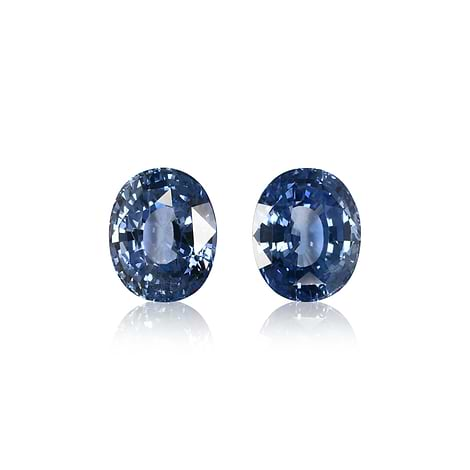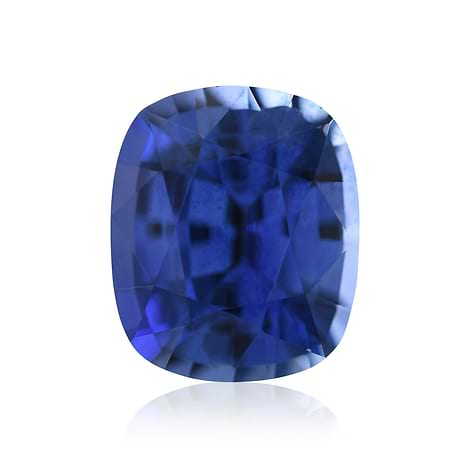Who doesn’t love owning a beautiful sapphire gemstone? But you always need to know how to tell if a sapphire is real. It may take some doing, but thankfully, there is a sapphire test, so you can be sure. The allure of real sapphire is obvious. Its luxurious, rich blue color has drawn true collectors for centuries. But those who love sapphire know it also comes in a rainbow of vivid hues to tempt any sapphire lover. Yellow, orange, pink and green are but some of the exciting shades you’ll find in sapphire.
With the emergence of man-made sapphire, you want to be certain you have an authentic sapphire. There are ways you can test at home to see if your sapphire is real. First, look inside the stone with a 10X loupe. If you see gas bubbles, it is synthetic sapphire.
A scratch test is also performed using a material harder than sapphire (9 on the Mohs Scale) like a diamond. Stones softer than 9 will not be able to make a mark on a real sapphire. A simple breath test is often used, too, which is discussed in this article.
Professional testing in a reputable gem lab is always a good idea. They have the proper instruments to thoroughly test the sapphire to determine its authenticity.
Understanding Sapphires
Earth-mined sapphires are called natural sapphires or genuine sapphires. But synthetic sapphires were created in a lab to replicate the characteristics of natural sapphires. Imitation sapphire look like but do not replicate the optical and physical properties of a natural sapphire.
You’ve seen blue sapphires, but they are also found in a wide range of attractive natural colors, which are referred to as fancy-color sapphires.
When natural sapphires do not have attractive coloration, they can be heat treated to improve both their color and their clarity, making them more salable.
Learn more about Sapphire and Sapphire as a Birthstone
Key Methods to Identify Real Sapphires
Check for Flaws and Inclusions
Like other natural gemstones, sapphires have inclusions which is one of the ways way professionals identify real sapphires. Expect to find feather-like inclusions and silk rutile throughout the stone. Color zoning of various strengths may be present, as are typical fingerprint inclusions.
While synthetic sapphires are as hard as real sapphires, imitation look-alikes are quite softer.
Perform a Breath Test
Breathe on your sapphire until it completely fogs up. Count the seconds until it's completely clear—which should be one or two seconds. Longer than that, and you may have a fake sapphire.

Use the Scratch Test
Make sure your scratch test is done safely—and only on your own gemstones. If the sapphire is not cut (called a rough or raw sapphire) you have greater liberty in scratch testing because the stone might be polished later on which will remove evidence of a scratch test.
Nevertheless, look for the most inconspicuous spot to make a discreet test. If the sapphire is already cut an faceted, try the scratch test on the underside (pavilion) of the stone, and as close to the girdle as possible. This way it will not be noticed.
With a diamond, make a minute scratch and then observe the results under a jewelers loupe. The diamond is 10 on the Mohs scale and will make a slight mark on real sapphire which is 9 on the Mohs scale.
If you scratch with a softer stone—like emerald, aquamarine or topaz it will not affect a real sapphire. It will scratch an imitation sapphire, however.
Observe Light Reflection
In a darkened room shine a flashlight on the sapphire. A real, sapphire will reflect light that is identical to the color of the sapphire. But If it’s an imitation, meaning it is made of glass or another man-made material, it will reflect other colors besides the color of the gem.
Examine for Air Bubbles
Part of the manufacturing process for man-made sapphire includes the present of air bubbles. They are never present in real sapphire. But you may need to look carefully under a microscope or with a jewelers 10X magnifying loupe to see them. Take your time inspecting each surface to verify if the stone is a real sapphire—or not.
Seek Professional Certification
Graduate gemologists and laboratory professionals are your best sources of authentication of you sapphire. They have the expertise and the finest grading instruments to verify if you have a real sapphire, or some other man-made stones.
The value and price of natural sapphires is always much greater that man made stones. With a lab report, you have the assurance in writing backed up by their authority that your stone is real, and it has the quality components identified.

FAQs
How can I check if my sapphire is real at home?
A simple scratch test and breath test done at home will help determine if your sapphire is real.
What are common signs that a sapphire might be synthetic?
Gas bubbles in the stone are an indicator of it being man-made.
How can I tell if my sapphire has been heat-treated?
Inclusions in heat treated sapphire do not look like natural ones—they may include missing areas of rutile inclusions. Coloration is also more uniform in heat treated sapphire.
What is the breath test for sapphires, and how does it work?
The breath test is simply done---breath on your sapphire closely until it completely fogs up. Count the seconds until the fog disappears which should be no more than 1 or 2 seconds—tops.
Are air bubbles a sure sign that a sapphire is fake?
Yes, air bubbles do not naturally occur in genuine sapphire.
How do I use the scratch test to verify a sapphire’s authenticity?
Since only a harder substance than sapphire can scratch it—try making a discreet mark on the stone with something harder—in this case, a diamond. Sapphire is so hard (ranking 9 on the Mohs scale) that only a diamond can make a mark on it.
Conclusion
Real sapphires are valuable and becoming more costly as time goes on. Genuine earth-mined sapphires are more rare than their man-made counterparts. So it’s important that collectors have a way of verifying their authenticity. That often means submitting the stone to a reputable grading lab. This brings peace of mind and provides proof of the sapphire being genuine and worth its value.
 LEIBISH Round Blue Sapphire Harmony Collection
LEIBISH Round Blue Sapphire Harmony Collection













